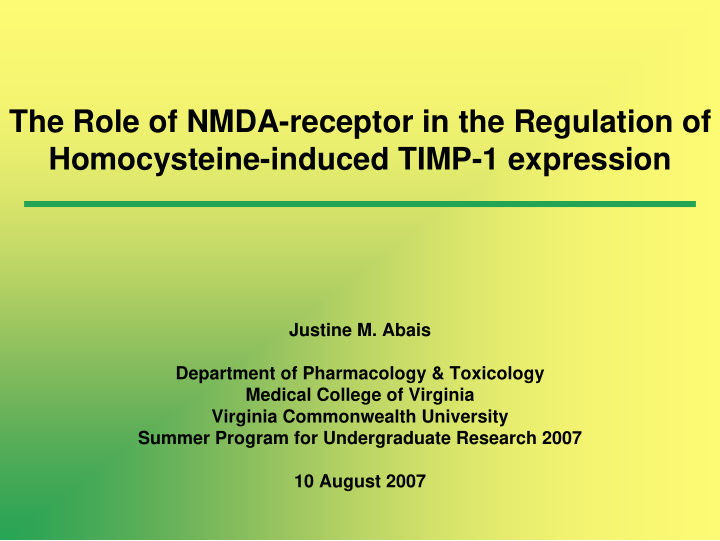



The Role of NMDA-receptor in the Regulation of Homocysteine-induced TIMP-1 expression Justine M. Abais Department of Pharmacology & Toxicology Medical College of Virginia Virginia Commonwealth University Summer Program for Undergraduate Research 2007 10 August 2007
Homocysteine - amino acid in the blood O SH HO - been shown to promote endothelial dysfunction, NH 2 the formation of the extracellular matrix (ECM), and the sclerotic process Homocysteine - stimulates the formation of tissue inhibitor of metalloproteinase-1 (TIMP-1) in renal mesangial cells - TIMP-1 is the most potent inhibitor of the TIMP family, and has been found to be the primary inhibitor of matrix metalloproteinase (MMP) activity - MMPs are responsible for breaking down collagen and regulating the formation and deposition of the ECM
Hyperhomocysteinemia - a critical pathogenic factor in the progression of end-stage renal disease (ESRD) and in the development of cardiovascular complications related to ESRD - 85-100% of patients in ESRD also suffer from hyperhomocysteinemia - even with hemodialysis, patients are still unable to recover - laboratory studies from animal models Homocysteine Levels < 10 µmol/L Normal 15-20 µmol/L Mild 30-60 µmol/L Moderate > 80 µmol/L Severe
N-methyl D-aspartate (NMDA)-receptor - ionotropic neurotransmitter receptor and ligand-gated nonselective cation channel - regulated by glutamate and glycine, which are both required for the channel activation and function - when activated, channel will depolarize and remove the Mg 2+ block, allowing for an influx of Ca 2+ ions - within some kinds of cells, NMDA receptors play a role in homocysteine uptake http://homepage.psy.utexas.edu/homepage/class/Psy301/Salinas/sec2/L&M/23.GIF
NMDA-receptor inhibitor MK801 (Dizocilpine) http://upload.wikimedia.org/wikipedia/commons/thumb/2/2d/MK801.jpg/180px-MK801.jpg - non-competitive antagonist of the NMDA receptor - binds to the inside of the receptor and prevents the flow of ions, including Ca 2+ - channel must be open, and this blockage inhibits drugs from binding
Proposed Mechanism - homocysteine enters the cell through NMDA-receptors - elevated homocysteine levels increase TIMP-1 levels, causing a decrease in MMP activity - decrease in MMP activity means collagen and other ECM cannot be cleaved - formation and deposition of ECM develops into glomerular injury associated with diabetes and hypertension
Hypothesis NMDA-receptors serve as the pathway for elevated levels of homocysteine to enhance TIMP-1 expression and suppress MMP activity, thereby leading to deposition of the ECM, which is the cause for glomerular injury associated with diabetes and hypertension.
Experimental Design Real-time RT-PCR used to measure the TIMP-1 mRNA level Western Blot Analysis used to measure the TIMP-1 protein level
Real time RT-PCR - method for amplifying a specific portion of an RNA molecule - two major components: 1) reverse transcription of RNA strand into complementary DNA (cDNA) 2) exponential amplification of cDNA using polymerase chain reaction - amplification is made possible through temperature-mediated DNA polymerase - DNA primers are added, and the iCycler RT-PCR Machine manipulates temperature to bind the sequence specific primers to the cDNA, make double-stranded DNA, and separate the two strands - the cycle repeats until million of duplicates are formed - highly sensitive technique, careful pipetting required
Real time RT-PCR Procedure Protocol - culture and treatment of mesangial cells - RNA Isolation - synthesis of cDNA - real-time RT-PCR http://cgb.indiana.edu/images/resources/bioradicycler.png
Effect of NMDA-receptor Inhibitor MK801 on the mRNA Level of TIMP-1 A Vehicle 3.5 MK801 Relative mRNA expression level of TIMP-1 * 3.0 (Normalized to control) 2.5 2.0 # 1.5 1.0 0.5 0.0 Hcys Glu Control Cys
Western Blot Analysis - alternately called immunoblot - method for detecting a specific protein of interest from a great mixture of proteins - gives information about size and expression amount of interest protein - protein-specific 1° antibody - species-specific 2 ° antibody http://www.westernblotting.org/THEORY.htm
Western Blot Procedure Protocol - culture and treatment of mesangial cells - gel electrophoresis - transfer from gel to membrane - membrane blocking - incubation of 1° and 2° antibodies - film exposure and developing - measure band density http://www.molecularstation.com/protein/western-blot/
Effect of NMDA-receptor Inhibitor MK801 on the Protein Level of TIMP-1 A TIMP-1 ~ 40 KD - 46 KD ß-actin Control Vehicle MK 801 Vehicle MK 801 Vehicle MK 801 MK 801 Glutathione Cysteine Homocysteine B Vehicle 1.6 MK801 Relative protein expression level of TIMP-1 1.4 1.2 (Normalized to control) 1.0 0.8 0.6 0.4 0.2 0.0 Glu Hcys Control Cys
Summary - The negative control, Glutathione, does not have a significant effect on either the relative mRNA or protein expression level of TIMP-1. - Another negative control, Cysteine, does not have an effect on the relative mRNA expression level of TIMP-1, but does cause an increase in the protein expression level. This signifies that Cysteine does not enter the cell through an NDMA-receptor, but through another unknown post-transcription pathway. - Homocysteine demonstrated significant increases in both the relative mRNA and protein expression levels of TIMP-1. - NMDA-receptor inhibitor MK801 repeatedly exhibited the tendency to reverse the mRNA and protein expression level increase caused by Homocysteine. This is significant in confirming the pathway of homocysteine within the mesangial cell.
Conclusion The mRNA detection method of Real-time RT-PCR and the protein detection method of Western Blot Analysis have both confirmed the role of NMDA-receptor as a significant pathway in Homocysteine-induced TIMP-1 expression. NMDA-receptor inhibitor MK801 was able to block and decrease TIMP-1 expression, where in its absence, Homocysteine caused considerably elevated levels of TIMP-1. Homocysteine-induced TIMP-1 expression is associated with NMDA-receptors mediated homocysteine uptake and stimulation.
Acknowledgement Dr. Pin-Lan Li Dr. Ai-Ping Zou Dr. Fan Yi Dr. Si Jin Dr. Fan Zhang Qi-Zheng Chen Min Xia Cindy Thomas Matt Childrey Thank you for an unforgettable summer! - Justine
Recommend
More recommend